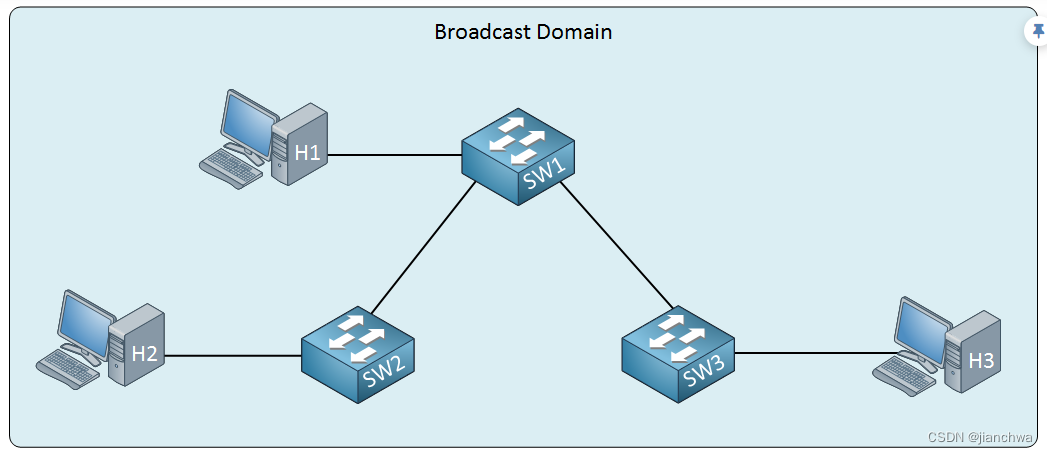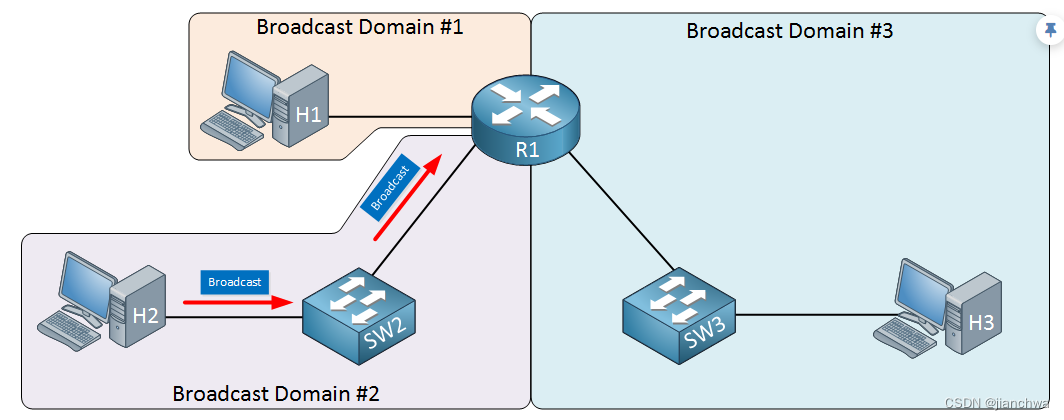目录
3 Collision vs Broadcast Domain
1 Key Words
关键名词1:
-
Node A node is a physical electronic device hooked up to a network, for example a computer, printer, router, and so on. If set up properly, a node is capable of sending and/or receiving information over a network.
-
Links Links connect nodes on a network. Links can be wired, like Ethernet, or cable-free, like WiFi. Links to can either be point-to-point, where Node A is connected to Node B, or multipoint, where Node A is connected to Node B and Node C.
-
Protocol A protocol is a mutually agreed upon set of rules that allows two nodes on a network to exchange data.
-
Networks A network is a general term for a group of computers, printers, or any other device that wants to share data. Network types include LAN, HAN, CAN, MAN, WAN, BAN, or VPN.
-
Topology Topology describes how nodes and links fit together in a network configuration, often depicted in a diagram. Here are some common network topology types:

关键名词2:
- Segments/Datagrams are units of data in the Transport Layer. In the case of the internet, the term Segment typically refers to TCP, while Datagram typically refers to UDP
- Packets are units of data in the Network Layer (IP in case of the Internet)
- Frames are units of data in the Link Layer (e.g. Wifi, Bluetooth, Ethernet, etc).

关键名词3
Promiscuous mode,混杂模式,
参考链接:Wikipedia Promiscuous modehttps://en.wikipedia.org/wiki/Promiscuous_mode
从中,我们提取一段:
In IEEE 802 networks such as Ethernet or IEEE 802.11, each frame includes a destination MAC address. In non-promiscuous mode, when a NIC receives a frame, it drops it unless the frame is addressed to that NIC's MAC address or is a broadcast or multicast addressed frame. In promiscuous mode, however, the NIC allows all frames through, thus allowing the computer to read frames intended for other machines or network devices.
当关闭混杂模式时,网卡会将Mac地址不是自己的Frame丢掉。
2 TCP/IP模型
OSI VS TCP/IP,以下部分内容参考What Is the OSI Model![]() https://www.imperva.com/learn/application-security/osi-model/
https://www.imperva.com/learn/application-security/osi-model/
OSI标准模型是7层的,但是广泛使用的TCP/IP模型只有4层,参考下图:

将Data Link Layer和Physical Layer合并为Netwrok Access Layer,在实践中体现为以太网卡包含了OSI Layer1/2的功能;这点,我们可以参考Search the Community What is the relationship of a NIC to the OSI model?![]() https://community.infosecinstitute.com/discussion/comment/133352#Comment_133352
https://community.infosecinstitute.com/discussion/comment/133352#Comment_133352
A NIC provides operations up to layer 2 of the OSI model. The NIC's interface itself is a Physical layer (layer 1) device, the physical address (also known as MAC address) of the adapter as well as the drivers to control the NIC are located at the Data Link layer's MAC sub-layer. In an Ethernet network for example, every NIC attached to the same segment receive every ‘frame’ to discover the MAC address. Frames that do not match the local NIC’s MAC address are discarded; frames that do match the local NIC’s address are forwarded up the OSI model to the next layer to be processed by the network layer protocol. Obviously, a NIC must be able to interpret the MAC address, hence operate up to the MAC sub-layer of layer 2 of the OSI model.
另外,有些文章中也说TCP/IP协议有五层,参考链接:
Layering TCP/IP Protocols Part 1![]() http://what-when-how.com/tcpip/layering-tcpip-protocols-part-1/
http://what-when-how.com/tcpip/layering-tcpip-protocols-part-1/ 
其中也谈到,layer1/2被包含在硬件里,
Layer 1: The physical layer
The physical layer at the bottom of the stack is pure hardware, including the cable or satellite (or other) connection medium and the network interface card. This layer is where electrical signals move around (and we try not to think too hard about how it works). Protocols in the two bottom hardware layers aren’t part of the TCP/IP stack. The physical layer transforms data into bits that move across the network media. The protocols in the physical layer include protocols related to cables, or to air, in the case of wireless. The physical layer also has protocols for connection methods.
Layer 2: The data link layer
This layer is another one that we don’t want to strain our brains trying to figure out — again, hardware is involved. This layer splits data into packets to be sent across the connection medium, and then wiring, such as Ethernet or token ring, gets involved. The data link layer moves data up through the higher layers for transportation across networks and through tunnels to Virtual Private Networks (VPNs).
The data link layer also includes protocols that work with your Media Access Control (MAC) address and your network interface card (NIC).
A MAC address is a hardwired special address on your NIC. Every NIC has a unique MAC address
3 Collision vs Broadcast Domain
3.1 概述
参考链接:Collision Domain vs Broadcast Domain![]() https://ipcisco.com/lesson/collision-domain-vs-broadcast-domain/
https://ipcisco.com/lesson/collision-domain-vs-broadcast-domain/
A domain is a network that has different network devices connected to it.
Collision domain is a single physical line that a collision can occur. In other words, it is a network domain that allows only one device to transfer data at a time. If one more device tries to send data at the same time in a collision domain, collision occurs. This means that there will be data loss.
Broadcast Domain simply shows a network. In other words, it is the area that a broadcast traffic can sent and received. All the devices that receive this broadcast traffic are in the same broadcast domain. If a device sends broadcast traffic, all the other devices in the same broadcast domain receive this broadcast traffic.
冲突域的早期解法是
Carrier-sense multiple access with collision detection (CSMA/CD) is a medium access control (MAC) method used most notably in early Ethernet technology for local area networking. It uses carrier-sensing to defer transmissions until no other stations are transmitting. This is used in combination with collision detection in which a transmitting station detects collisions by sensing transmissions from other stations while it is transmitting a frame. When this collision condition is detected, the station stops transmitting that frame, transmits a jam signal, and then waits for a random time interval before trying to resend the frame
总结起来,关于冲突域有两点:
- 它是早期网络发展的一个阶段,LAN里的节点都处在一个冲突域中
- 它定义了一种类型的Network Domain,即里面的所有节点不能同时发送数据
关于广播域,参考链接:
For example, let’s say that that ARP request is sent by H2 to figure out the MAC address of H1. The information in the ARP request is useless for SW2, SW3, and H3 but they do receive it. SW2 and SW3 have to waste bandwidth forwarding the broadcast frame and H3 has to waste some CPU cycles to look at an ARP request that it doesn’t care about.
Routers, unlike switches, do not forward broadcast traffic. When H2 sends that broadcast frame, it will be forwarded by SW2 to R1 but that’s it. This does mean that traffic from H2 to H1 will have to be routed but that’s another story. Here are the broadcast domains we have now:
对于广播域,总结起来有两点:
- 广播域定义了一个network domain,其中broadcast traffic可以被所有节点接收
- 广播域也应该是LAN发展的一个阶段,随着LAN的规模越来越大,需要一种设备将一个广播域分为多个,于是就出现了Router;Router的功能之一就是划分隔离广播域
3.2 发展脉络
下面我们再看下大概的发展脉络:
总线式LAN

中继器(repeater),我们可以简单的理解为,可以将两个共享以太网连接起来的接口,同时有放大信号减少衰弱的作用。

集线器(Hub),hub是个星型的中继器

Repeater和Hub都只是简单的以太网的传输介质连接起来。
网桥(bridge),通过记录端口对应的MAC地址,网桥可以将网段1和网段2隔离成两个冲突域,

交换机(switch),则是一个多端口的网桥,它的每个端口可以构成一个冲突域;不过实践中,每个端口通常只链接一个节点;
























 87
87











 被折叠的 条评论
为什么被折叠?
被折叠的 条评论
为什么被折叠?








